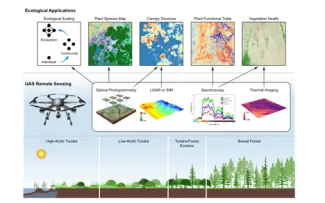Remote Sensing from Unoccupied Aerial Systems: Opportunities to Enhance Arctic Plant Ecology in a Changing Climate
The Arctic is warming at a faster rate than any other biome on Earth, resulting in widespread changes in vegetation composition, structure, and function that have important feedbacks to the global climate system.
The heterogeneous nature of Arctic landscapes creates challenges for monitoring and improving understanding of these ecosystems, as current efforts typically rely on ground, airborne or satellite-based observations that are limited in space, time, or pixel resolution.
The use of remote sensing instruments on small UASs has emerged as an important tool to bridge the gap between detailed, spatially limited ground-level measurements and lower-resolution, spatially expansive high-altitude airborne and satellite observations. Here, the team reviewed how established and emerging UAS remote sensing technologies can enhance Arctic plant ecological research by quantifying fine-scale vegetation patterns and processes, and by enhancing the ability to link ground-based measurements with broader-scale information obtained from airborne and satellite platforms. The team shared recommendations to better enable and encourage the use of UASs to improve the description, scaling, and model representation of Arctic vegetation.
Unoccupied aerial system (UAS) remote sensing brings new opportunities for scientists to understand the complexity of Arctic ecosystems and improves scaling and model representation of Arctic vegetation.
Yang, D., et al. 2022. “Remote sensing from unoccupied aerial systems: Opportunities to enhance Arctic plant ecology in a changing climate.” Journal of Ecology 13976. https://doi.org/10.1111/1365-2745.13976.
This research was supported by the Director, Office of Science, Office of Biological and Environmental Research of the US Department of Energy under Contract No. DE-AC02-05CH11231 as part of the Next-Generation Ecosystem Experiments (NGEE Arctic) project.
- Alaska
- NGEE Arctic Utqiagvik (Barrow), Alaska
- Seward Peninsula, Alaska
- NGEE Arctic Kougarok Site, Mile Marker 64, Alaska
- NGEE Arctic Kougarok Site, Mile Marker 86, Alaska
- NGEE Arctic Kougarok Site, Mile Marker 80, Alaska
- NGEE Arctic Teller Site, Mile Marker 27, Alaska
- NGEE Arctic Teller Site, Mile Marker 47, Alaska
- NGEE Arctic Council Site, Mile Marker 71, Alaska


